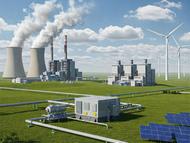Growing the Grid - ORIGINAL CONTENT
- By:
- Edward A. Reid Jr.
- Posted On:
- Jun 9, 2025 at 6:00 AM
- Category
- Energy Policy, Climate Change
The Federal Energy Regulatory Commission (FERC) and the North American Electric Reliability Corporation (NERC) have warned that the reliability of the US electric grid is threatened by the increasing percentage of intermittent wind and solar generation being connected to the grid and the premature closure of conventional generation capacity, particularly coal, but also natural gas and nuclear generators. The transition to renewable generation has been driven by massive federal incentives for renewable generation and state renewable portfolio standards, all focused on achieving Net Zero carbon dioxide emissions by 2050. The FERC and NERC concerns are heightened by the projected rapid increases in electricity demand and consumption required to serve data centers and AI.
The Trump Administration has shifted focus from Net Zero by 2050 to achieving American energy dominance. The Administration has removed restrictions on new coal mining projects and is encouraging the retention of existing coal generation and the construction of new coal generation facilities. The Administration is also working to eliminate restrictions on natural gas production and gas pipeline expansion. The Administration also plans to remove unnecessary restrictions on and excessive delays in approval and construction of new nuclear generation facilities including small modular reactors (SMRs).
This new federal policy direction would permit utilities to select the best mix of generation technologies to serve the needs of their markets, although utilities in states with Renewable Portfolio Standards (RPS) would be constrained to comply with the RPS requirements, unless they were modified or eliminated by state or federal actions. The Trump Administration should strongly encourage the RPS states to reconsider the application of those standards, which are driving increasing electricity costs.
The data center and AI developers have made it clear that they are not satisfied with the reliability and stability of renewable generation. In states with RPS, they are likely to build dedicated conventional generation facilities to serve their needs, rather than expose themselves to the growing utility renewable generation fleets. Several are planning to build natural gas combined-cycle generators while others are considering nuclear SMRs. In non-RPS states, they are considering either connecting to the serving utility or partnering with the serving utility to construct additional generation.
Unfortunately, the policy changes implemented by the Trump Administration could be reversed by a subsequent Administration committed to Net Zero by 2050. This creates an uncertain investment environment for utilities and independent generation developers, particularly those operating and developing coal and natural gas generation capacity. Reinstitution of controls such as the Biden Administration’s Clean Power Plan (CPP) could adversely affect the generating capacity and operating economics of those generators or ultimately require their premature closure.
Congress should act to clarify its intent regarding CO2 and Methane emissions under the Clean Air Act. That action, in combination with the recent Supreme Court position on Chevron Deference, would improve the investment environment and make utilities, independent generation developers and their investors more willing to move forward timely and aggressively to restore and maintain grid reliability and resiliency.


